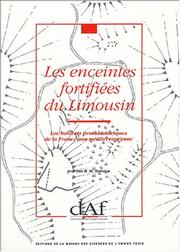| Listing 1 - 10 of 10 |
Sort by
|

ISBN: 0852635362 9780852635360 Year: 1981 Publisher: Aylesbury: Shire,
Abstract | Keywords | Export | Availability | Bookmark
 Loading...
Loading...Choose an application
- Reference Manager
- EndNote
- RefWorks (Direct export to RefWorks)
Fortification, Prehistoric --- Fortification, Prehistoric --- England --- Wales
Book
ISBN: 9789732900222 9732900229 Year: 1989 Publisher: Bucureṣti: Ed. ştiinţifică şi enciclopedică,
Abstract | Keywords | Export | Availability | Bookmark
 Loading...
Loading...Choose an application
- Reference Manager
- EndNote
- RefWorks (Direct export to RefWorks)
Dacians --- Fortification, Prehistoric --- Excavations (Archaeology)
Book
Year: 1992 Publisher: Marburg: Philipps-Universität,
Abstract | Keywords | Export | Availability | Bookmark
 Loading...
Loading...Choose an application
- Reference Manager
- EndNote
- RefWorks (Direct export to RefWorks)
Anglo-Saxons --- Fortification, Prehistoric --- England --- Wales
Book
ISBN: 0860540871 9780860540878 Year: 1980 Volume: 79 Publisher: Oxford : BAR,
Abstract | Keywords | Export | Availability | Bookmark
 Loading...
Loading...Choose an application
- Reference Manager
- EndNote
- RefWorks (Direct export to RefWorks)
Iron age --- Fortification, Prehistoric --- % 9611AR --- Scotland --- Antiquities --- Brochs. --- Iron age - Scotland --- Fortification, Prehistoric - Scotland --- Scotland - Antiquities
Book
ISBN: 9782364414860 2364414865 Year: 2023 Publisher: Dijon Éditions Universitaires de Dijon
Abstract | Keywords | Export | Availability | Bookmark
 Loading...
Loading...Choose an application
- Reference Manager
- EndNote
- RefWorks (Direct export to RefWorks)
« Monuments emblématiques du Néolithique, répandus d'un bout à l'autre de l'Europe, les enceintes restent encore méconnues en dehors du cercle des spécialistes. Elles étaient faites de bois et de terre et leurs fossés ont été depuis longtemps comblés, leurs talus nivelés par l'érosion et les labours, et leurs palissades ont disparu. Souvent peu de vestiges subsistent donc de ces constructions qui pouvaient enclore de vastes espaces, jusqu'à plusieurs dizaines d'hectares. Certaines enceintes, aménagées au sommet d'escarpements naturels et munies de puissants remparts, constituaient des fortifications. D'autres, à peine moins imposantes, accueillaient des cérémonies collectives. Parfois utilisées sur plusieurs générations, toutes jouèrent un rôle structurant dans l'organisation des territoires. La vingtaine de contributions rassemblées dans ce volume vient questionner la diversité de ces enceintes, de leur typologie, de leur chronologie et de leur fonction, tout autant que celle des approches développées par les archéologues. »--Page 4 de la couverture.
Néolithique --- Enclos préhistoriques --- Néolithique --- Enclos préhistoriques --- Neolithic period --- Fortification, Prehistoric
Book

ISBN: 9782503579955 2503579957 Year: 2019 Publisher: Turnhout Brepols
Abstract | Keywords | Export | Availability | Bookmark
 Loading...
Loading...Choose an application
- Reference Manager
- EndNote
- RefWorks (Direct export to RefWorks)
Back cover: Located along the River Euphrates, in modern-day Syria, el-Qitar was a mountain fortress of the Middle Bronze Age. Excavations, fully analysed in this volume for the first time, revealed extensive fortifications, with two city gates, multiple towers, a fosse, an earthen rampart, and casemate walls, in addition to a public building lined with orthostats of the Middle Bronze Age. After a short time, the site was abandoned and, following a gap of several centuries, re-settled in the Late Bronze Age. It was then that upper and lower settlements were established within the old fortifications, possibly in the wake of Hittite campaigns in Northern Syria that destroyed nearby towns. Detailed analyses of ceramics and objects explore the possibility that el-Qitar was re-occupied by local refugees. This volume traces the changing function of the site over time, arguing that el-Qitar might have been the site known as Dur Samsi-Addu during the Middle Bronze Age, and Til-Abnu of the Late Bronze Age. The latest construction episode belongs to the modern-day Tishreen Dam.
Fouilles archéologiques --- Âge du bronze --- Architecture militaire --- Fortifications --- Bronze age --- Excavations (Archaeology) --- Syria --- Antiquities --- Fortification, Prehistoric --- Fortification, Prehistoric - Syria --- Excavations (Archaeology) - Syria --- Bronze age - Syria --- Antiquities, Prehistoric - Syria --- El-Oitar
Book
ISBN: 2877723070 9782877723077 Year: 2005 Publisher: Paris : Errance,
Abstract | Keywords | Export | Availability | Bookmark
 Loading...
Loading...Choose an application
- Reference Manager
- EndNote
- RefWorks (Direct export to RefWorks)
Celts --- Cities and towns, Ancient --- Fortification, Prehistoric --- Civilization, Celtic --- Excavations (Archaeology) --- Dwellings --- Europe --- Antiquities, Celtic --- Archaeology - Fortifications - Urban history - Celtic cities - Gaul. --- Dwellings. --- Antiquities, Celtic. --- Civilization, Celtic. --- Celts - Dwellings --- Cities and towns, Ancient - Europe --- Fortification, Prehistoric - Europe --- Excavations (Archaeology) - Europe --- Europe - Antiquities, Celtic

ISBN: 0860540464 9780860540465 Year: 1979 Volume: 62 Publisher: Oxford British archaeological reports
Abstract | Keywords | Export | Availability | Bookmark
 Loading...
Loading...Choose an application
- Reference Manager
- EndNote
- RefWorks (Direct export to RefWorks)
Fortification, Prehistoric --- Iron age --- Fortifications préhistoriques --- Age du fer --- Great Britain --- Grande-Bretagne --- Antiquities --- Antiquités --- Antiquities, Celtic --- Britons --- -Iron age --- -Civilization --- Hill-forts --- Prehistoric fortification --- Archaeology --- Brythons --- Celts --- Ethnology --- Antiquities, Celtic. --- Britons. --- -Great Britain --- Fortifications préhistoriques --- Antiquités --- -Brythons --- Fortification, Prehistoric - Great Britain --- Iron age - Great Britain --- Great Britain - Antiquities, Celtic

ISBN: 2735104427 9782735104420 2735125866 Year: 2021 Volume: 36 Publisher: Paris : Éditions de la Maison des sciences de l’homme,
Abstract | Keywords | Export | Availability | Bookmark
 Loading...
Loading...Choose an application
- Reference Manager
- EndNote
- RefWorks (Direct export to RefWorks)
Que sait-on des habitats de la Gaule non méditerranéenne à la fin de l’âge du Fer ? Peu de choses par rapport à ce que l’on connaît des sites contemporains de la bordure méditerranéenne. L’étude d'I.B.M. Ralston, faite à partir d'un inventaire des sites d’une région, le Limousin, contribue à combler cette lacune. En comparant ces données avec celles fournies par d'autres régions françaises et en confrontant les sources archéologiques, numismatiques et textuelles, l'auteur propose une analyse de la société et de l'émergence probable des entités étatiques à la veille de la conquête romaine. Il se place délibérément dans une perspective régionale, à l'inverse des approches macroscopiques antérieures dont il fait la critique. What is known about the settlement sites of non-Mediterranean Gaul at the end of the Iron Age? Relatively little compared to our knowledge of contemporary sites near the Mediterranean littoral. This study, based on a regional inventory of the settlement sites of Limousin, is a contribution to filling that gap. The author considers archaeological, numismatic and historical data from Corrèze, Creuse and Haute-Vienne in relation to information from other regions of France, and proposes an analysis of Gaulish society and political structures in the immediately pre-Conquest period. The study is avowedly regionalist in perspective and offers a critique of earlier, brooder- scale models of change during this period.
Excavations (Archaeology) --- Dwellings, Prehistoric --- Fortification, Prehistoric --- Protohistory --- Fouilles (Archéologie) --- Habitations préhistoriques --- Fortifications préhistoriques --- Protohistoire --- France --- Antiquities --- Antiquités --- Earthworks (Archaeology) --- Limousin (France) --- Fouilles (Archéologie) --- Habitations préhistoriques --- Fortifications préhistoriques --- Antiquités --- Earthworks (Archaeology) - France - Limousin --- Excavations (Archaeology) - France - Limousin --- Limousin (France) - Antiquities --- Archaeology --- habitat --- analyse spatiale --- César --- fortification --- âge du Fer --- inventaire --- enceinte quadrangulaire --- Guerre des Gaules
Book

ISBN: 2735101460 9782735101467 2735120481 Year: 2021 Volume: no 2 Publisher: Paris : Éditions de la Maison des sciences de l’homme,
Abstract | Keywords | Export | Availability | Bookmark
 Loading...
Loading...Choose an application
- Reference Manager
- EndNote
- RefWorks (Direct export to RefWorks)
Les architectures de terre et de bois d’époque romaine étaient, il y a quelques années encore, très mal connues. Des fouilles récentes ont apporté de nombreuses données. Cet ouvrage tente un premier point : s’agit-il de survivances protohistoriques ? comment se présentent ces techniques de construction ? à quelles conditions socio-économiques répondent-elles ? L’approche archéologique et textuelle s’accompagne des enseignements livrés par des expériences contemporaines. Earth and wood constructions of the Roman era were, until several years ago, very little known. Recent excavations have provided us with considerable information. This work attempts to answer primary questions such as : are these protohistorical survivals ? what construction techniques were used ? what socio-economic conditions do they correspond to ? The textual and archaeological approach go along with informationobtained by contemporary experiments.
City planning --- Planification urbaine --- Building, Wooden --- Earthworks (Archaeology) --- Congresses --- Europe --- Gaul --- Antiquities --- Buildings, Wooden --- Congresses. --- Wood construction --- Wooden architecture --- Wooden building --- Building --- Excavations (Archaeology) --- Fortification, Prehistoric --- Gallia --- Gaule --- Council of Europe countries --- Eastern Hemisphere --- Eurasia --- Antiquités --- Congrès --- Building with wood --- Building, Wooden - Europe - Congresses --- Building, Wooden - Gaul - Congresses --- Earthworks (Archaeology) - Europe - Congresses --- Earthworks (Archaeology) - Gaul - Congresses --- Europe - Antiquities - Congresses --- Gaul - Antiquities - Congresses --- habitat --- Moyen Âge --- Antiquité --- Protohistoire --- monde romain --- province occidentale --- INDE --- GEOGRAPHIE URBAINE --- VILLES
| Listing 1 - 10 of 10 |
Sort by
|

 Search
Search Feedback
Feedback About UniCat
About UniCat  Help
Help News
News